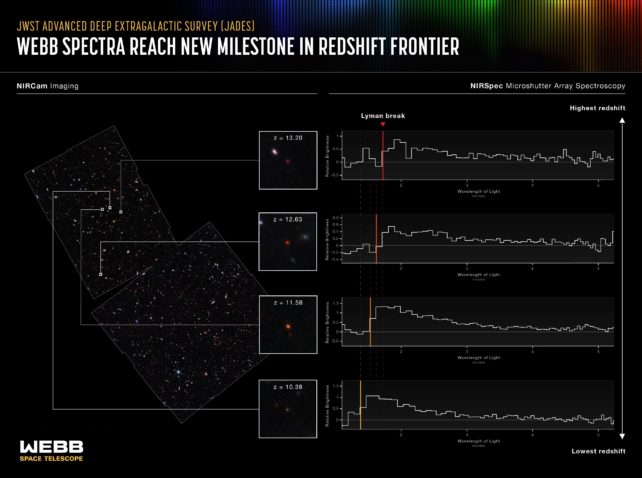The light that has traveled more than 13.4 billion years to reach our neighborhood of space has been confirmed to have originated from the oldest and most distant galaxy yet discovered.
This places the furthest of these four very small objects at the dawn of the universe, shortly after the Big Bang – a period of time when the universe was still hazy and cloudy and the first rays of light were piercing through the darkness.
very detailed JWSTThe researchers’ long-running spectroscopic observations indicate that researchers can not only measure the distance traveled by the light of these galaxies, but also infer some properties of the galaxies.
“For the first time, we discovered galaxies only 350 million years after the Big Bang, and we can be absolutely confident of their fantastic distances,” says astronomer Brant Robertson from the University of California Santa Cruz.
“Finding these early galaxies in such stunningly beautiful images is a special experience.”
To be able to peer into the universe much earlier than we’ve ever seen before was one of the greatest hopes for JWST. Our understanding of the first billion years after the Big Bang is very limited, and finding earlier and first bodies can help shed light on this crucial time of formation.

We have models that describe how events unfold. We think that before the first stars were born, the universe was filled with opaque matter; Any light scattered by free electrons and unable to flow freely.
These particles gradually combine to form neutral hydrogen; When stars began to form, they ionized hydrogen, and the light lit up. This process was completed about a billion years after the emergence of the universe.
The light emitted from these objects is very faint, having traveled from a very far away place. Because the universe has expanded, it has greatly stretched to the longer, redder end of the spectrum, a phenomenon known as redshift.
The JWST is the most powerful telescope ever launched into space, specializing in the infrared and near infrared – designed to detect this red light, to the best of our ability.
To get a confirmed redshift, the light must be broken down into its component wavelengths, a technique known as spectroscopy. A team of researchers split the light from JWST’s NIRCam into nine wavelength bands, focusing on four high-redshift galaxies, two of which were first identified by Hubble.
New JWST data confirms that these two galaxies are indeed among the most distant galaxies ever discovered – and that the other two are farther away.
“It was very important to prove that these galaxies did indeed inhabit the early universe. It is very possible that even closer galaxies disguised themselves as very distant galaxies,” says astronomer Emma Curtis Lake from the University of Hertfordshire in the UK.
“Seeing the spectrum unfolded as we had hoped, confirming that these galaxies are at the true edge of our view, and some are farther away than Hubble can see! It’s a very exciting feat of the mission.”

The two Hubble galaxies have redshifts of 10.38 and 11.58. The new JWST finds have redshifts of 12.63 and 13.20 — the latter equivalent to about 13.5 billion light-years away.
Other candidates for the top red shifts are currently under investigation, but not yet confirmed. Since JWST hasn’t been live for six months now, it probably won’t be long before the record is broken.
But there’s a lot to get done in the meantime. The observations given to us by these distant galaxies as part of JWST’s Advanced Deep Extragalactic Survey (JADES) collected a total of 28 hours of data from a region of space in and around the famous region. The Hubble Ultra Deep Field.
This light will be able to tell us a lot about conditions in the early universe, and how the first stars and galaxies formed.
“Using these measurements, we can find out the intrinsic brightness of galaxies and find out how many stars they have.” Robertson says.
“Now we can begin to map out how galaxies come together over time.”
The researchers will present their findings at STScI’s First scientific findings from JWST conspiracy. My paper can be read before printing over here And the over here.

“Beer aficionado. Gamer. Alcohol fanatic. Evil food trailblazer. Avid bacon maven.”
